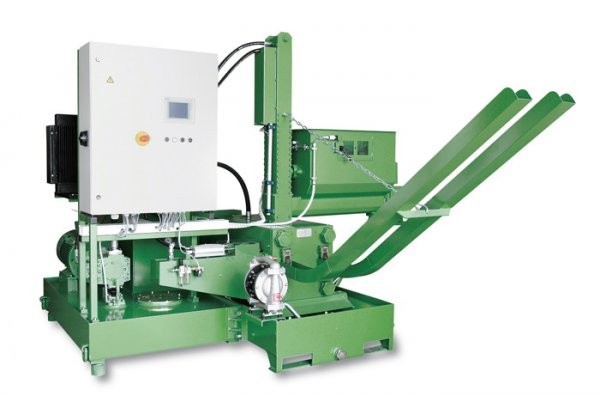Squeezing value from scrap
How briquetting can bring extra value to recycling operations

At its most basic level, briquetting is a process that compresses metal scrap and waste into compact, easy-to-manage round blocks (briquettes) with densities and resale values that rival those of solid metals. The idea of briquetting isn’t new – it’s been around for more than 50 years – but the technology and benefits of using it have evolved greatly over the years. For example, old-style briquetting machines were big, loud and high-maintenance. Today, briquetting systems are just the opposite.
“Our briquetting systems are engineered specifically to run reliably and efficiently, and deliver the same or better production rates while using less horsepower,” said Bob Kimber, Product Manager, RUF, Inc. “The technological advancements we’ve made allow us to design machines that use innovative hydraulics and have smaller footprints that are easier to integrate into existing operations.”
As the technology and performance of briquetting have advanced, so have the potential benefits that it holds for recyclers and scrap processors. Briquetting boosts the bottom line for recyclers by adding value to the waste stream. For a relatively small investment, briquetting enables processors to get more, higher quality product to mills, more efficiently – reducing energy, labour and transportation costs while increasing revenue.
Quality and flexibility
Briquettes provide a degree of quality control to recyclers that isn’t possible with loose chips and other swarf (chips, turnings, filings, shreds and shavings received from manufacturing operations). By compressing loose materials into briquettes, many excess fluids and other contaminants are forced out, creating a more homogenous product that is more dense, less prone to corrosion and more desirable to foundries and other re-users. This makes recycler’s scrap more marketable, salable and profitable.
In addition to the scrap metal itself, if enough metalworking fluid (MWF) is extracted and collected from batches of loose swarf from a particular source, it may be re-salable back to the supplier or to other interested processors or manufacturers.
Briquetting systems can also accommodate a wide range of different ferrous and non-ferrous materials including steel, cast-iron, aluminum, copper, brass, bronze, magnesium, titanium, zinc and more. And, they can accept them in practically any pre-processed form of swarf.
“Basically, if it’s metal, it’s briquettable. RUF briquetters can even squeeze value out of the metal found in sludge and metalworking fluids,” states Kimber.
Resale value, storage and logistics
Obviously, mills and foundries are in business to make money. So, if a recycler can provide them with a product that is purer, denser, and as ready to melt as possible, they will pay a premium for it. Briquettes make life easier for mills and foundries because they are cheaper and simpler to transport, store and melt than loose scrap. This saves money and increases profit margins in the long run. Foundries benefit by being able to place scrap that closely mimics the properties of solid metal directly into furnaces, without the special preparations often required for loose materials prior to charging. Briquettes also significantly reduce losses to oxidation and filter dust in furnaces.
Condensing tons of loose scrap metal into easy-to-manage, stackable briquettes makes a world of difference on a recycler’s storage and logistics operations. In fact, some of the most striking benefits that briquettes offer come through time, money and space savings associated with these areas. Briquettes allow recyclers to palletize their product before warehousing or shipping to mills and foundries – reducing volume by up to 20:1.
This reduction in volume means that the product being delivered to market is significantly heavier and more valuable, and that more of it can be transported or stored at the same or reduced cost, when compared to loose scrap. It’s also much cleaner in general (it’s easier to manage a pallet of briquettes than overflowing bins of swarf) and residual chemicals. And because most MWF and other contaminants have been forced out during the briquetting process, less planning and costs are accrued in safeguarding against potentially negative environmental impacts during shipping, processing and storage.
Energy, maintenance and labour
“With very low wear and maintenance costs over the lifetime of a machine,” explains Kimber. “And because they can process as much loose scrap as larger, more energy-intensive machines with less horsepower and smaller footprints, the savings on utilities alone can be significant.”
On the labour front, because some briquetting systems can be set up to run automatically, 24 hours a day, with little or no human oversight, manpower can be used in more productive ways than machine baby-sitting – reducing labour costs and getting more from operators and technicians.
What it all means
Briquetting is a cost-effective method for recyclers to handle and prepare loose scrap of practically any kind for resale to mills and foundries. It adds value to the waste stream by creating a higher-quality product that’s similar to that of solid scrap – transforming carts full of messy chips and other assorted swarf into pallets of neatly stacked, more marketable briquettes. Briquetting systems can help recyclers and processors achieve these benefits, as well as cost savings in storage, logistics, utilities, maintenance and labour, with custom-built systems that are tailored to their specific needs.

